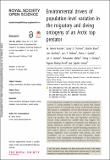Environmental drivers of population-level variation in the migratory and diving ontogeny of an Arctic top predator
Abstract
The development of migratory strategies that enable juveniles to survive to sexual maturity is critical for species that exploit seasonal niches. For animals that forage via breath-hold diving, this requires a combination of both physiological and foraging skill development. Here, we assess how migratory and dive behaviour develop over the first year of life for a migratory Arctic top predator, the harp seal Pagophilus groenlandicus, tracked using animal-borne satellite relay data loggers. We reveal similarities in migratory movements and differences in diving behaviour between 38 juveniles tracked from the Greenland Sea and Northwest Atlantic breeding populations. In both regions, periods of resident and transitory behaviour during migration were associated with proxies for food availability: sea ice concentration and bathymetric depth. However, while ontogenetic development of dive behaviour was similar for both populations of juveniles over the first 25 days, after this time Greenland Sea animals performed shorter and shallower dives and were more closely associated with sea ice than Northwest Atlantic animals. Together, these results highlight the role of both intrinsic and extrinsic factors in shaping early life behaviour. Variation in the environmental conditions experienced during early life may shape how different populations respond to the rapid changes occurring in the Arctic ocean ecosystem.
Citation
Grecian , W J , Stenson , G B , Biuw , M , Boehme , L , Folkow , L P , Goulet , P J , Jonsen , I D , Malde , A , Nordøy , E S , Rosing-Asvid , A & Smout , S 2022 , ' Environmental drivers of population-level variation in the migratory and diving ontogeny of an Arctic top predator ' , Royal Society Open Science , vol. 9 , no. 3 , 211042 . https://doi.org/10.1098/rsos.211042
Publication
Royal Society Open Science
Status
Peer reviewed
ISSN
2054-5703Type
Journal article
Description
This work is an output of the ARISE project (NE/P006035/1 and NE/P00623X/1), part of the Changing Arctic Ocean programme jointly funded by the UKRI Natural Environment Research Council (NERC) and the German Federal Ministry of Education and Research (BMBF). Fieldwork in Canada was carried out under a Canadian Council on Animal Care permit no. NAFC2017–2 and funded by Fisheries and Oceans Canada and a bursary from Department for Business, Energy and Industrial Strategy (BEIS) administered by the NERC Arctic Office. Fieldwork in the Greenland Sea was approved by the Greenland Ministry of Fisheries, Hunting and Agriculture and the Norwegian Food Safety Authority (permit no. 11546) as part of the Northeast Greenland Environmental Study Program 2017–2018 (by the Danish Centre for Environment and Energy at Aarhus University, The Greenland Institute of Natural Resources and the Environmental Agency for Mineral Resource Activities of the Government of Greenland) and financed by oil licence holders in the area.Collections
Items in the St Andrews Research Repository are protected by copyright, with all rights reserved, unless otherwise indicated.

